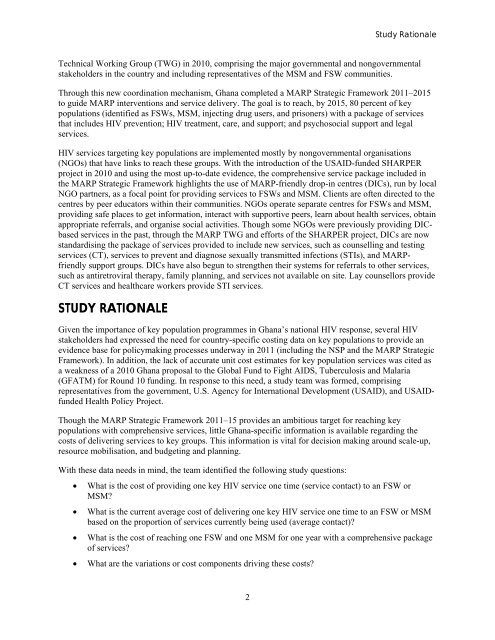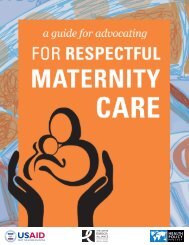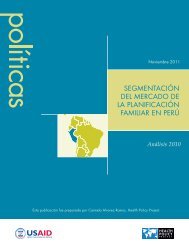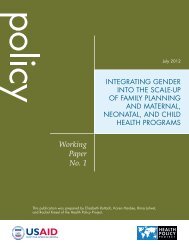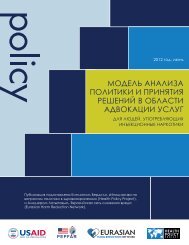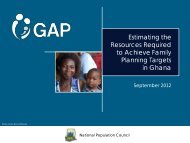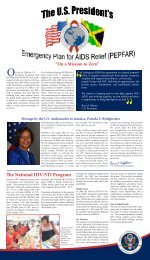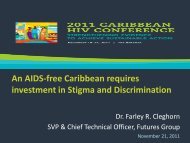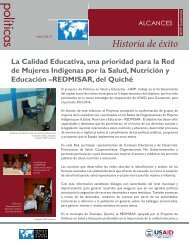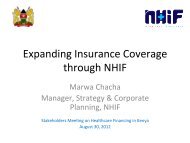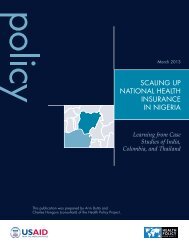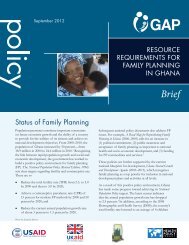Working Paper No. 6 - Health Policy Project
Working Paper No. 6 - Health Policy Project
Working Paper No. 6 - Health Policy Project
Create successful ePaper yourself
Turn your PDF publications into a flip-book with our unique Google optimized e-Paper software.
Study Rationale<br />
Technical <strong>Working</strong> Group (TWG) in 2010, comprising the major governmental and nongovernmental<br />
stakeholders in the country and including representatives of the MSM and FSW communities.<br />
Through this new coordination mechanism, Ghana completed a MARP Strategic Framework 2011–2015<br />
to guide MARP interventions and service delivery. The goal is to reach, by 2015, 80 percent of key<br />
populations (identified as FSWs, MSM, injecting drug users, and prisoners) with a package of services<br />
that includes HIV prevention; HIV treatment, care, and support; and psychosocial support and legal<br />
services.<br />
HIV services targeting key populations are implemented mostly by nongovernmental organisations<br />
(NGOs) that have links to reach these groups. With the introduction of the USAID-funded SHARPER<br />
project in 2010 and using the most up-to-date evidence, the comprehensive service package included in<br />
the MARP Strategic Framework highlights the use of MARP-friendly drop-in centres (DICs), run by local<br />
NGO partners, as a focal point for providing services to FSWs and MSM. Clients are often directed to the<br />
centres by peer educators within their communities. NGOs operate separate centres for FSWs and MSM,<br />
providing safe places to get information, interact with supportive peers, learn about health services, obtain<br />
appropriate referrals, and organise social activities. Though some NGOs were previously providing DICbased<br />
services in the past, through the MARP TWG and efforts of the SHARPER project, DICs are now<br />
standardising the package of services provided to include new services, such as counselling and testing<br />
services (CT), services to prevent and diagnose sexually transmitted infections (STIs), and MARPfriendly<br />
support groups. DICs have also begun to strengthen their systems for referrals to other services,<br />
such as antiretroviral therapy, family planning, and services not available on site. Lay counsellors provide<br />
CT services and healthcare workers provide STI services.<br />
STUDY RATIONALE<br />
Given the importance of key population programmes in Ghana’s national HIV response, several HIV<br />
stakeholders had expressed the need for country-specific costing data on key populations to provide an<br />
evidence base for policymaking processes underway in 2011 (including the NSP and the MARP Strategic<br />
Framework). In addition, the lack of accurate unit cost estimates for key population services was cited as<br />
a weakness of a 2010 Ghana proposal to the Global Fund to Fight AIDS, Tuberculosis and Malaria<br />
(GFATM) for Round 10 funding. In response to this need, a study team was formed, comprising<br />
representatives from the government, U.S. Agency for International Development (USAID), and USAIDfunded<br />
<strong>Health</strong> <strong>Policy</strong> <strong>Project</strong>.<br />
Though the MARP Strategic Framework 2011–15 provides an ambitious target for reaching key<br />
populations with comprehensive services, little Ghana-specific information is available regarding the<br />
costs of delivering services to key groups. This information is vital for decision making around scale-up,<br />
resource mobilisation, and budgeting and planning.<br />
With these data needs in mind, the team identified the following study questions:<br />
• What is the cost of providing one key HIV service one time (service contact) to an FSW or<br />
MSM<br />
• What is the current average cost of delivering one key HIV service one time to an FSW or MSM<br />
based on the proportion of services currently being used (average contact)<br />
• What is the cost of reaching one FSW and one MSM for one year with a comprehensive package<br />
of services<br />
• What are the variations or cost components driving these costs<br />
2


